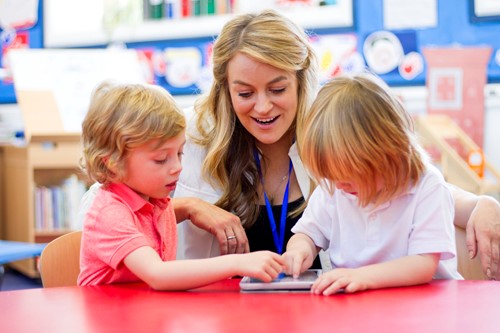By Michael Hilkemeijer
Collaborative learning involves children learning in pairs or small groups through different learning activities.
It is student-centric and provides children with a sense of autonomy over their educational process.
It also builds the communication and social skills of children while increasing their motivation and engagement in group activities.
Collaboration in early childhood education is important because when children share joint attention in activities this process provides a significant cognitive challenge in itself.
Studies have also indicated that those who favour ICT are likely to value collaborative working, enquiry and decision-making by children. This is one of the reasons why positively encouraging collaborative learning is a key principle in teaching ICT capability in early childhood education.
Planning in Early Childhood Education
The use of technology in preschool activities, looking at computers in particular, offers a rich range of possibilities for collaborative learning in the zone of proximal development.
Therefore, the best organisational strategies for the early years setting should be at the most basic level to be able to make computers more a part of the general experience of play and dialogue alongside the writing area, the modelling, the books and play equipment.
“It means making the computer accessible for use in a range of contexts, both collaboratively and singly, with an adult and without an adult, in the same way as any Early Years activity might be designed to maximise learning opportunities.” - Allan, Potter, Sharp & Turvey
Issues in Collaborative Learning
Computer-based activities actually promote collaborative learning more than any other classroom activity.
The computer screen is more public than a page of writing and has a natural tendency to bring young children together to share ideas and to discuss what they are they doing on the computer.
However, it is important to bear in mind that a further difficulty is the collaborative nature of ICT.
For example, when children use ICT in meaningful contexts it is a practical experience for them and this sometimes makes it hard to separate out the individual contributions to a joint project.
In addition, some pairings can lead to an unequal sharing of responsibility or effort.
Pairs may have included keyboard hoggers at times while in other instances, there may be those who lack confidence or experience.
They could be afraid to expose their perceived inadequacy to public scrutiny.

What is the Solution?
To overcome this hurdle, you can use several strategies such as the following:
You could give the children specific roles or tasks when engaged in an activity – this is best suited to those activities that have specific components such as shooting a video or searching for information.
You could also signal change overs regularly during a lesson to ensure pairs get equal access to the keyboard – this approach is ideal for young children.
An example of this would be if you are using an approach to teaching new ICT skills where the activity has been ‘chunked’ into sub tasks, the pairs could alternate when completing each sub task.
Another idea would be to ‘prepare on and off-computer tasks’ during an ICT lesson.
Back to the example that I provided earlier about joint contributions or projects this issue can be overcome if you talk to the children or ask older children to write a reflective report about the approach they used to complete a project.
It is for this reason why it is important that when you are planning collaborative learning with technology in preschool activities that you ask the right questions.
In the past, successful teachers had given careful thought for the teaching strategies for ICT, and this had influenced the way in which resources were allocated and children grouped for ICT activities.

Pairing Children for Collaborative Learning
As discussed earlier, the pairing of children can create issues.
However, if you consider these factors, you will be less stressed when planning collaborative learning in early childhood education.
Differences in ICT capability
A more capable child could be used as a mentor for less capable child. The less capable child will learn more if the mentor has a clear idea of the role and you as the teacher, occasionally reinforce this role.
The personalities of the children
Dominance from one of the pair could lead to the disengagement of the other in the task or activity. You should pair dominant children together whenever possible.
Sex
Single sex pairs generally cooperate more successfully. However, when boys are paired together they tend to take turns rather than work together.
Nature of the task
Will both children be collaborating on one outcome? Or will they be assisting each other with their individual pieces of work?